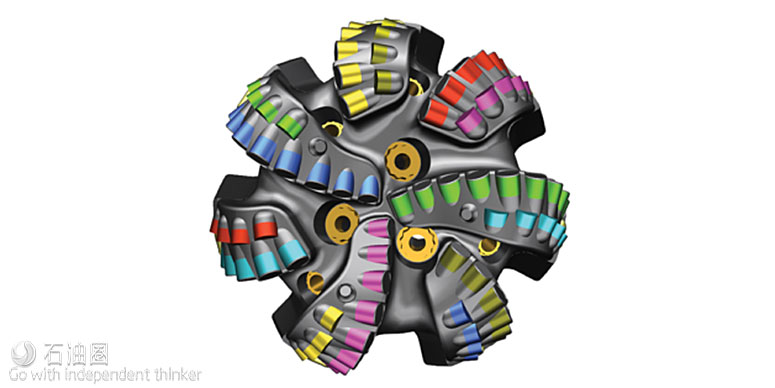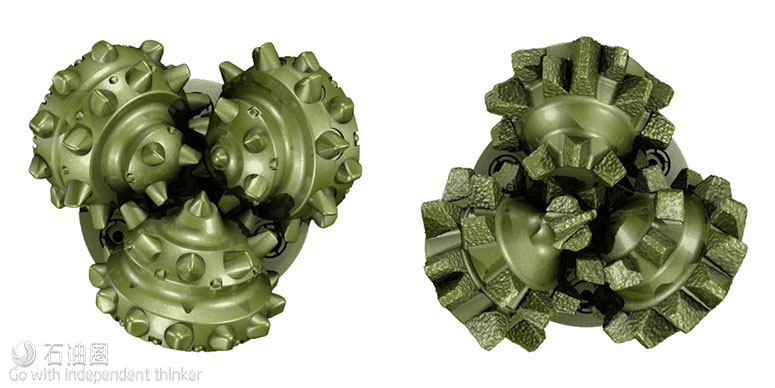Although a drill bit is but one component of a large and complex drilling system, it can have an outsized impact on the efficiency of a drilling operation. “While the amount of money spent on drill bits may be less than 1% of the total cost of the well, it can really be argued that no single component contributes more to the overall drilling performance,” said Wiley Long, Bits and Drilling Tools Product Champion at Smith Bits, a Schlumberger company.
In response to these needs from operators, service and tool companies have used advanced modeling and finite element analyses to understand the major barriers to ROP and durability, including poor cuttings evacuation, high thermal generation and vibrations. Based on these understandings, they’ve developed new cutter geometries and layouts and improved the hydraulics of the bit.
In the past, increasing ROP often would decrease durability. But in today’s drill bits, higher bit durability and ROP can go hand-in-hand, Mr Campbell said. “Historically, with drill bits, you had to balance these competing objectives, ” he said. “When we tried to increase the durability of the bit, often through increased diamond volume, that would hurt the ROP.” Now, advances with cutter layout in drill bits have helped eliminate this either/or proposition, he added. Cutters are remaining sharper for longer, helping operators to maintain ROPs throughout the section being drilled.
Bringing in backup
The shape and material of a cutter or insert can improve a bit’s durability and ROP, but so can the layout of the bit’s cutters, Halliburton’s Mr Campbell said. In late March, the company will introduce a new cutter layout, the Stega, which features backup cutters that radially offset the primary cutters.
Using radially offset backup cutters creates the same effect on ROP as using larger, more aggressive cutters but without the detrimental effects on durability, Mr Campbell said. “The larger cutters would attack the formation more aggressively and boost ROP. Unfortunately, these cutters had a less solid cutting structure, so it would wear down faster,” he explained. “With Stega, we can drill as fast as these aggressive bits, but we still have a very durable bit.
”
In Q1 2017, a bit with the Stega layout was used to drill a 2,900-ft long, 9 1/4-in. section of a well in Kuwait. This section passes through the Zubair, a soft sandstone with intercollations of shale. From there, it runs through the Ratawi formation, which consists of shale, sandstone and limestone interbedded with shale. Finally, the section passes through the Minagish formation, which is a very hard limestone with low porosity. It’s not uncommon for operators to use two drill bits to drill this section.
“It’s difficult to design a bit that’s going to have enough durability to drill these different formations with an acceptable ROP to survive the run,” Mr Campbell said. When the Stega was deployed on a bit drilling this section, the operator was able to drill the entire section with a single bit and double the drilling footage achieved in offset runs, with an average ROP of 19.84 ft/hr. When the run was complete, the bit had a dull condition of 1-1. “We took the entire interval out in one bit, and we did not compromise the overall section ROPs, so ultimately we saved a trip plus the cost of an additional bit,” he said.
In another run in the Mulicinco formation in Argentina, a Stega-layout bit was able to double the footage per run, from an average of 1,250 ft per run to 2,395 ft per run. “The prior runs were averaging about 21.9 ft per hour, and the Stega bit came in at about 20.9 ft per hour, so it’s very similar ROP with double the footage, which was the objective of the field run,” Mr Campbell said.
In addition to Kuwait and Argentina, the Stega design has been run in the North Sea, Oman and the Rockies in the US.
The Stega design will be an optional feature for Halliburton’s GeoTech fixed-cutter PDC bits platform, launched in 2017. “GeoTech was designed to utilize our latest materials technologies, modeling technologies and cutting structure technologies, packaging them into a platform that our design and field engineers can then adapt to customize according to customer needs,” Mr Campbell said.
New configurations for better attack
Smith Bits has also been developing new cutter configurations to minimize damage and dulling during long runs. “The name of the game is keeping your cutting structure sharp for the entire interval so it’s able to drill with a higher ROP consistently throughout the entire run,” Mr Long said. In November 2017, the company launched the Xplorer Helix spiral TCI configuration, a roller cone bit with tungsten carbide inserts (TCIs) arranged in a spiral configuration. “The spiral layouts of Xplorer Helix configuration increase the amount of contact area that the inserts are making with the bottom of the hole for every bit rotation.”
When TCIs on a roller cone bit are arranged in concentric rows, as they typically are, they’re vulnerable to insert tracking, according to Mr Long. As the bit drills, it creates craters in the formation. “If you’re falling back into an existing crater, you’re not getting very efficient rock crushing,” he explained. The spiral layout eliminates this effect and ensures that every insert makes contact with fresh rock as the bit drills. Reducing insert tracking also prevents the inserts from breaking and allows the cutting structure to remain sharp.
The spiral layout of the Xplorer Helix configuration was modeled using the IDEAS integrated dynamic design and analysis platform suite of finite element analysis tools, providing insight into how various TCI layouts would crush rock. “We ran simulations and monitored how the inserts were contacting the bottom of the hole and how that translated into ROP,” Mr Long said. “Then we created initial iterations of our cutting structure.”
He noted that company had considered developing a spiral insert layout in the past, but it was only with recent advances in computing power, which allowed the company to produce more complex and realistic models, that the Xplorer Helix configuration was able to go from idea to reality.
In 2017, the Xplorer Helix configuration was deployed for Kuwait Oil Company to drill a vertical 28-in. section from 500- to 5,000-ft measured depth through an interbedded formation of soft and hard limestone, dolomite, anhydrite and shale layers. This formation had compressive strengths ranging from 6,000 to 24,000 psi. “The highly interbedded nature of the interval often caused insert breakage,” Mr Long said, and translated to reduced ROP.
When the Xplorer Helix configuration was deployed in this section, it achieved an ROP of 43.9 ft/hr, which is 107% higher than the field-best ROP of 21.1 ft/hr in similar applications. Ultimately, the operator saved four drilling days using the new bit. “We were able to eliminate the risk of insert tracking and keep the cutting structure sharp throughout the interval,” he said. “Couple that with the more efficient crushing action and we were able to more than double the ROP.”

 石油圈
石油圈


